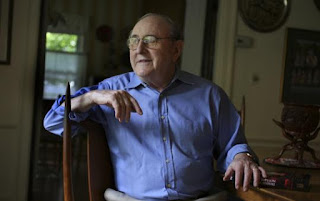The 93 year old Dr Bernard Lown nips upstairs and comes back with a signed copy of his memoir, The Lost Art of Healing; and another slim volume Never Whisper in the Presence of Wrong. The latter is a selection from speeches he gave on nuclear war and global survival. Never whisper in the presence of wrong. It resonates. And he lived by it. Still does.
I am at Harvard briefly as a Bernard Lown visiting professor. It will entail another couple of visits to Harvard – no penance. The best part is the privilege of taking tea with Dr Bernard Lown at his home in Chestnut Hill, a leafy suburb of Boston. (I suspect that there is an inverse correlation between age of Harvard medical professors and the distance west of the Longwood Medical Area of Boston that they live. The newer the recruit, the further out they have to live. Harvard professors, high status, no doubt have long life expectancy, keeping the desirable properties occupied. That said, at 93, Dr Lown must be among the more senior. He is relatively close in.)
I know him as the co-founder, with brother cardiologist Evgeni Chazov of the Soviet Union, of International Physicians for the Prevention of Nuclear War (IPPNW) in 1980. They were awarded the Nobel Peace Prize in 1985. Leaning against a wall, I nearly dislodged a photo of Lown meeting with Mikhail Gorbachev in the Kremlin.
Bernard Lown - Image Source Boston Globe 2008
But there’s so much more. All over the world, patients with cardiac arrhythmias can be treated with cardioversion, a DC electrical shock to the heart, timed to miss a vulnerable interval in the cardiac cycle. Lown developed that. Patients with heart attacks used to be confined to absolute bed rest for weeks. Now they are mobilised quickly to prevent venous thromboembolism and pneumonia. Lown and Dr Samuel Levine, his mentor in cardiology at the Peter Bent Brigham Hospital of Harvard, were responsible for that. Patients treated with digitalis and diuretics could develop fatal cardiac complications. Lown showed that low potassium – which could be caused by diuretics – made digitalis potentially toxic. He did as much as anyone to draw attention to the issue of sudden cardiac death.
He was an early and firm believer in the importance of the mind in both the onset and recovery from cardiovascular disease. Had he done nothing else, his reputation would be secure as having made a fundamental and lasting contribution to the management of patients with cardiovascular disease. But he always saw clearly his wider responsibility to society.
Why is a cardiologist based at Harvard School of Public Health? He graduated from Johns Hopkins in 1945. American paranoia about communism, which led to the excesses of McCarthyism, meant that belonging to many student organisations with a social responsibility put you beyond the pale politically. Simply, his political beliefs made him difficult to employ in the fevered atmosphere of the time. Seems bizarre now. A Harvard professor, he has twenty honorary degrees, numerous medals and awards, a Nobel Peace Prize, and all the recognition as a clinician and scientist that one could imagine. Yet his undoubted ability was not enough. When the famous Brigham hospital was closed to him, he looked around Harvard, but the politics seemed to get in the way. Finally, he found Dr Fred Stare, head of Nutrition, at Harvard School of Public Health who offered him a job, and space for a research lab. Lown told Dr Stare that there were some political issues he should know about. Stare’s response: you’re an American; that’s all I need to know.
The frustration was that the two and a half hours I spent with Dr Lown, and his wife since 1946, Louise, meant that we had only just got started. He said he would give me the tour on my next visit.
Much to discuss.

